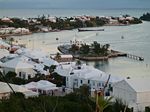World Heritage Site
 From Nwe
From Nwe A UNESCO World Heritage Site is a specific site (such as a forest, mountain, lake, desert, monument, building, complex, or city) that has been nominated and confirmed for inclusion on the list maintained by the international World Heritage Programme administered by the UNESCO World Heritage Committee, composed of 21 State Parties (countries) which are elected by the General Assembly of States Parties for a fixed term. [1](This is similar to the United Nations Security Council.)
The program was founded with the Convention Concerning the Protection of World Cultural and Natural Heritage, which was adopted by the General Conference of UNESCO on November 16, 1972. Since then, over 180 State Parties have ratified the convention.
The goal of the program is the conservation of sites deemed to be of outstanding cultural or natural importance to the common heritage of humankind. UNESCO funds numerous efforts to preserve and restore sites in developing nations through the World Heritage Fund. In addition, World Heritage designations often boost local economies by encouraging tourism. Each World Heritage Site is the property of the country on whose territory the site is located, but it is considered in the interest of the international community to preserve each site for future generations of humanity. The protection and conservation of these sites are a concern of all the World Heritage countries and its citizens.
History







Pre-convention
In 1959, the government of Egypt decided to build the Aswan High Dam, an event that would flood a valley containing treasures of ancient civilization such as the Abu Simbel temples. UNESCO then launched a worldwide safeguarding campaign, despite appeals from the governments of Egypt and Sudan. The Abu Simbel and Philae temples were taken apart, moved to a higher location, and put back together piece-by-piece.
The cost of the project was approximately US $80 million, about $40 million of which was collected from 50 different countries. It was widely regarded as a total success, and led to other safeguarding campaigns (saving Venice and its lagoon in Italy, the ruins of Mohenjo-daro in Pakistan, and the Borobodur Temple Compounds in Indonesia). UNESCO then initiated, with the International Council on Monuments and Sites, a draft convention to protect the common cultural heritage of humanity.
Convention and background
The United States initiated the idea of combining cultural conservation with nature conservation. A White House conference in 1965 called for a World Heritage Trust to preserve "the world's superb natural and scenic areas and historic sites for the present and the future of the entire world citizenry."[2] The International Union for Conservation of Nature developed similar proposals in 1968, and they were presented in 1972 to the United Nations conference on Human Environment in Stockholm, Sweden.
A single text was ultimately agreed on by all parties involved, and the Convention Concerning the Protection of the World Cultural and Natural Heritage was adopted by the General Conference of UNESCO on November 16, 1972.
Benefits of a World Heritage Site designation
The designation as a World Heritage Site brings a certain prestige to a location and its home country. Increasing the awareness of a site and its history also increases awareness of the need to preserve and protect.
The value of a WHS designation is understood throughout the world to the extent that it enlists international cooperation in preservation efforts. A comprehensive management plan accompanies a site's designation including adequate preservation measures and monitoring mechanisms. Experts offer technical training to local sites' management teams.
An additional benefit is financial support. Approximately $4 million dollars is made available annually to assist in identifying, preserving and promoting World Heritage sites. There is an emergency fund specified for urgent actions necessitated by damage caused by man-made or natural disasters.
If a site is listed on the List of World Heritage in Danger the attention and the funds of both the national and the international community are focused on the conservation needs of these particularly threatened sites.[3]
Nominating process
A country must first take an inventory of all its significant cultural and natural properties. This is called the Tentative List, and is important because a country may not nominate properties as a World Heritage Site unless they have first been included on this Tentative List. Next, it selects a property from this list and prepares a special file on it, called a 'Nomination File'. The World Heritage Centre offers advice and help in preparing this file, which needs to be as comprehensive as possible.
The file is then independently evaluated by two organizations: the International Council on Monuments and Sites and the World Conservation Union. These bodies then make their recommendations to the World Heritage Committee. The Committee meets once per year to determine whether or not to inscribe each nominated property on the World Heritage List, and sometimes defers the decision to request more information from the States Parties (States Parties are defined as countries that signed and ratified The World Heritage Convention). There are ten selection criteria that a site must meet to be included on the list.
Selection criteria
Until the end of 2004, there were six criteria for cultural heritage and four criteria for natural heritage. In 2005, this was modified so that there is only one set of ten criteria. Nominated sites must be of "outstanding universal value" and meet at least one of the ten criteria.[4]
Cultural criteria
- I. "to represent a masterpiece of human creative genius";
- II. "to exhibit an important interchange of human values, over a span of time or within a cultural area of the world, on developments in architecture or technology, monumental arts, town-planning or landscape design";
- III. "to bear a unique or at least exceptional testimony to a cultural tradition or to a civilization which is living or which has disappeared";
- IV. "to be an outstanding example of a type of building, architectural or technological ensemble or landscape which illustrates (a) significant stage(s) in human history";
- V. "to be an outstanding example of a traditional human settlement, land-use, or sea-use which is representative of a culture (or cultures), or human interaction with the environment especially when it has become vulnerable under the impact of irreversible change";
- VI. "to be directly or tangibly associated with events or living traditions, with ideas, or with beliefs, with artistic and literary works of outstanding universal significance. (The Committee considers that this criterion should preferably be used in conjunction with other criteria)";
Natural criteria
- VII. "to contain superlative natural phenomena or areas of exceptional natural beauty and aesthetic importance";
- VIII. "to be outstanding examples representing major stages of earth's history, including the record of life, significant on-going geological processes in the development of landforms, or significant geomorphic or physiographic features";
- IX. "to be outstanding examples representing significant on-going ecological and biological processes in the evolution and development of terrestrial, fresh water, coastal and marine ecosystems and communities of plants and animals";
- X. "to contain the most important and significant natural habitats for in-site conservation of biological diversity, including those containing threatened species of outstanding universal value from the point of view of science or conservation."
Statistics
As of December 2007, there were 851 properties forming part of the cultural and natural heritage which the World Heritage Committee considers as having outstanding universal value. These include 660 cultural, 166 natural, and 25 mixed properties in 141 States Parties. As of October 2006, 184 States Parties have ratified the World Heritage Convention. An updated listing of world heritage sites is maintained by the UNESCO World Heritage Centre branch of the United Nations.
Further site classification includes the classification of the State Parties among five geographic zones: Africa, Arab States (composed of northern Africa and the Middle East), Asia-Pacific (includes Australia and Oceania), Europe and North America (specifically, USA and Canada), and Latin America and the Caribbean. Russia is classified as belonging to the Europe and North America zone, together with Cyprus and the Caucasus States.
The UNESCO geographic zones also give greater emphasis on administrative, rather than geographic associations. Hence, Gough Island, located in the South Atlantic, is part of the Europe and North America region since it was the United Kingdom which nominated the site.
The table below includes a breakdown of the sites according to these zones and their classification:
| Zone | Natural | Cultural | Mixed | Total | Percent |
|---|---|---|---|---|---|
| Africa | 33 | 38 | 3 | 74 | 9 percent |
| Arab States | 3 | 58 | 1 | 62 | 7 percent |
| Asia-Pacific | 45 | 126 | 11 | 182 | 21 percent |
| Europe & North America | 51 | 358 | 7 | 416 | 49 percent |
| Latin America & Caribbean | 34 | 80 | 3 | 117 | 14 percent |
World Heritage Committee Session
The World Heritage Committee meets several times a year to discuss measures on the management of existing World Heritage Sites, and accept the nominations from interested countries. A session, known as the World Heritage Committee Session, takes place annually in which sites are officially inscribed on the World Heritage List, following presentations made by the IUCN and/or ICOMOS, and deliberations made among the State Parties.
The annual session takes place in various cities throughout the world. With the exception of those held in Paris, the site of the UNESCO headquarter office, only State Parties who are members of the World Heritage Committee have the right to host a Session, pending approval by the Committee, provided the concerned State Party's term will not expire before it hosts the Session.
| Session | Year | Date | Host City | State Party |
| 1 | 1977 | 27 June - 1 July | Paris | |
| 2 | 1978 | 5 September - 8 September | Washington, D.C. | |
| 3 | 1979 | 22 October - 26 October | Cairo & Luxor | |
| 4 | 1980 | 1 September - 5 September | Paris | |
| 5 | 1981 | 26 October - 30 October | Sydney | |
| 6 | 1982 | 13 December - 17 December | Paris | |
| 7 | 1983 | 5 December - 9 December | Florence | |
| 8 | 1984 | 29 October - 2 November | Buenos Aires | |
| 9 | 1985 | 2 December - 6 December | Paris | |
| 10 | 1986 | 24 November - 28 November | Paris | |
| 11 | 1987 | 7 December - 11 December | Paris | |
| 12 | 1988 | 5 December - 9 December | Brasilia | |
| 13 | 1989 | 11 December - 15 December | Paris | |
| 14 | 1990 | 7 December - 12 December | Banff | |
| 15 | 1991 | 9 December - 13 December | Carthage | |
| 16 | 1992 | 7 December - 14 December | Santa Fe | |
| 17 | 1993 | 6 December - 11 December | Cartagena | |
| 18 | 1994 | 12 December - 17 December | Phuket | |
| 19 | 1995 | 4 December - 9 December | Berlin | |
| 20 | 1996 | 2 December - 7 December | Mérida | |
| 21 | 1997 | 1 December - 6 December | Naples | |
| 22 | 1998 | 30 November - 5 December | Kyoto | |
| 23 | 1999 | 29 November - 4 December | Marrakesh | |
| 24 | 2000 | 27 November - 2 December | Cairns | |
| 25 | 2001 | 11 December - 16 December | Helsinki | |
| 26 | 2002 | 24 June - 29 June | Budapest | |
| 27 | 2003 | 30 June - 5 July | Paris | |
| 28 | 2004 | 28 June - 7 July | Suzhou | |
| 29 | 2005 | 10 July - 17 July | Durban | |
| 30 | 2006 | 8 July - 16 July | Vilnius | |
| 31 | 2007 | 23 June - 1 July | Christchurch |
Notes
- ↑ World Heritage. About World Heritage Retrieved December 7, 2007.
- ↑ UNESCO World Heritage Centre.Brief History Retrieved March 13, 2008.
- ↑ UNESCO World Heritage Site. Benefits of Ratification Retrieved March 13, 2008.
- ↑ World Heritage. Criteria for Selection Retrieved March 13, 2008.
External links
All links retrieved October 10, 2020.
- UNESCO World Heritage Sites Official website of UNESCO World Heritage Sites
- List of UNESCO World Heritage Sites Official website
- World Heritage Site A personal travel guide to the entries on the World Heritage List
- UNESCO World Heritage List Complete list with links and map of all sites
|
|||||||
Credits
New World Encyclopedia writers and editors rewrote and completed the Wikipedia article in accordance with New World Encyclopedia standards. This article abides by terms of the Creative Commons CC-by-sa 3.0 License (CC-by-sa), which may be used and disseminated with proper attribution. Credit is due under the terms of this license that can reference both the New World Encyclopedia contributors and the selfless volunteer contributors of the Wikimedia Foundation. To cite this article click here for a list of acceptable citing formats.The history of earlier contributions by wikipedians is accessible to researchers here:
The history of this article since it was imported to New World Encyclopedia:
Note: Some restrictions may apply to use of individual images which are separately licensed.
↧ Download as ZWI file | Last modified: 02/04/2023 12:13:00 | 76 views
☰ Source: https://www.newworldencyclopedia.org/entry/UNESCO_Heritage_Site | License: CC BY-SA 3.0
 ZWI signed:
ZWI signed:










 KSF
KSF